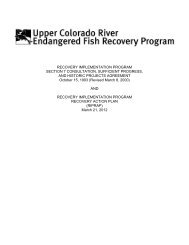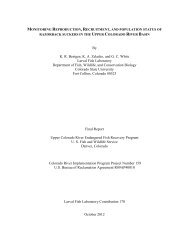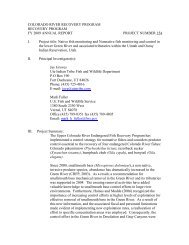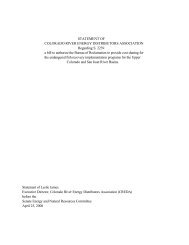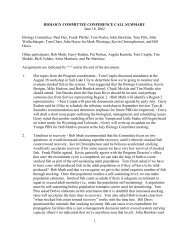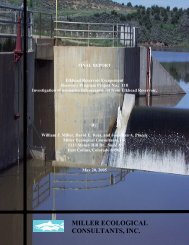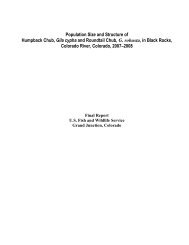The 120,000 acre-feet/year <strong>of</strong> new depletions represents the amount <strong>of</strong> additional Reclamationand non-Reclamation water that the Service believes could be depleted from the Upper ColoradoRiver Basin above the confluence with the Gunnison River using new or existing facilities(including depletions that have already occurred since September 1995) and not result in thelikelihood <strong>of</strong> jeopardy or adverse modification <strong>of</strong> critical habitat so long as the recovery actionsare implemented as described herein.The 120,000 acre-feet/year depletion includes non-Reclamation projects and/or facilities that havecurrent biological opinions but have not yet depleted the full amount covered by those biologicalopinions and water that could be depleted in the near future from facilities without a currentFederal nexus. However, non-Reclamation facilities are treated as interrelated because <strong>of</strong> thelikelihood that they will have a Federal nexus at some future point and want to rely on theRecovery Program to avoid the likelihood <strong>of</strong> jeopardy and adverse modification <strong>of</strong> critical habitat.The Federal nexus will likely come in the <strong>for</strong>m <strong>of</strong> facility repairs requiring Army Corps <strong>of</strong>Engineers permits, Federal Energy Regulatory Commission relicensing, Federal agencyauthorization <strong>of</strong> right-<strong>of</strong>-ways, or some other Federal involvement. This 120,000 acre-footreduction in flows is expected to have the same effect on endangered fish and their critical habitatif removed by existing or new projects. However, we cannot make a judgement on exactly wherethis 120,000 acre-feet/year <strong>of</strong> depletion will come from and anticipate that some <strong>of</strong> it will comefrom facilities that have yet to be constructed.In recognition <strong>of</strong> the extreme variability <strong>of</strong> hydrology and water use demand patterns, the 120,000acre-feet <strong>of</strong> new depletions will be calculated as a 10 year moving average as determined by theColorado Water Conservation Board in consultation with Reclamation and concurred with by theService (Appendix B).The following elements <strong>of</strong> the Recovery Action Plan are measures completed, ongoing, or futureactions which are part <strong>of</strong> the action subject to this consultation. As part <strong>of</strong> the action, thebeneficial effects <strong>of</strong> these recovery actions are taken into consideration in the jeopardy andincidental take analysis. It is the Recovery Program’s responsibility to ensure that all elements <strong>of</strong>the Recovery Action Plan affecting the Colorado River and other rivers are completed and/orimplemented consistent with Recovery Program schedules (contained in the April, 1999, “Section7 Consultation, Sufficient Progress, and Historic Projects Agreement and Recovery Action Plan”and subsequent revisions).The following elements <strong>of</strong> the Recovery Action Plan address the biological and habitat needs <strong>of</strong>the endangered fishes, each element involves several recovery actions. These needs are describedin the “Status <strong>of</strong> the Species and Critical Habitat” section <strong>of</strong> this document.7
81. Habitat Protection ElementGeneral protectionThe Service and the Colorado Water Conservation Board entered into a Memorandum <strong>of</strong>Agreement on September 21, 1993, wherein the Board agreed to “. . . take such actions understate law, including requesting administration by the State Engineer and the appropriate divisionengineer and initiating water court proceedings, as may be necessary to fully exercise its waterrights or to obtain delivery <strong>of</strong> acquired water or interest in water. Such water shall be protectedwithin the entire stream reach <strong>for</strong> which the appropriation or acquisition is made.” Thisagreement (commonly called the En<strong>for</strong>cement Agreement) provided a legal mechanism to protectwater obtained <strong>for</strong> the endangered fish under the Recovery Program. Categories <strong>of</strong> water thiscould apply to include contract deliveries, water leases, and acquired water rights.Late Summer and Fall Base flow period augmentationOn September 2, 1997, the Colorado Water Court granted the CWCB an instream flow decree<strong>for</strong> 581 cfs in the 15-Mile Reach during July, August, and September. This decree protects theOrchard Mesa Pumping and Power Plant return flows that enter the river at the top <strong>of</strong> the 15-MileReach. In addition, the Colorado Water Court has granted the CWCB a 300 cfs instream flowright <strong>for</strong> water accretions occurring in the 15-Mile Reach during July, August, and September.These two instream flow rights provide protection from future diversions <strong>of</strong> water in the 15-MileReach. Additionally, 5,000 acre-feet annually plus an additional 5,000 acre-feet, 4 out <strong>of</strong> 5 years,is made available from Ruedi Reservoir by Reclamation, in consultation with the Service and theCWCB when needed by the fish. Protection <strong>of</strong> these releases is accomplished pursuant to theterms <strong>of</strong> an agreement between Reclamation, the CWCB, and the Service, which provides <strong>for</strong> thedelivery and protection <strong>of</strong> that water in stream to and through the 15-Mile Reach. Typically theService requests deliveries during July, August, and September.In accordance with a 1995 biological opinion <strong>for</strong> Ruedi Reservoir Round II Water Sales, whichwas amended January 6, 1999, Reclamation, Colorado Water Conservation Board and the Servicehave signed 1-year agreements <strong>for</strong> 21,650 acre-feet/year <strong>of</strong> water (in addition to the 5,000 acrefeet/yearplus 5,000 acre-feet 4 out <strong>of</strong> 5 years mentioned above) from Ruedi Reservoir. Underthe amended Ruedi opinion, Reclamation is to provide the 21,650 acre-feet <strong>of</strong> water from RuediReservoir <strong>for</strong> a period <strong>of</strong> 15 years through short- or long-term agreements beginning the first yearthe Recovery Program pays associated operation and maintenance costs, which costs were firstpaid <strong>for</strong> water released in 1998. Also, under the amended opinion, Reclamation proceeded withimmediately contracting <strong>for</strong> up to 6,135 acre-feet <strong>of</strong> 17,000 acre-feet <strong>of</strong> Ruedi Round II watersales.This programmatic biological opinion will take precedence over the amended Ruedi opinion, butdoes not require additional commitments <strong>of</strong> water from Ruedi Reservoir. Reclamation’s21,650 acre-foot/year commitment is reduced by half, when the water users provide 10,825
- Page 1 and 2: FINAL PROGRAMMATIC BIOLOGICAL OPINI
- Page 3 and 4: INCIDENTAL TAKE ...................
- Page 5 and 6: 2" Reclamation’s portion of 120,0
- Page 7 and 8: On January 21-22, 1988, the Secreta
- Page 9: funding component of the Recovery P
- Page 13 and 14: Also, the Service and the Colorado
- Page 15 and 16: Table 1. The estimated benefits in
- Page 17 and 18: through recovery efforts that will
- Page 19 and 20: native fishes. Also, some species o
- Page 21 and 22: “new” depletions. This would in
- Page 23 and 24: Based on early fish collection reco
- Page 25 and 26: infrequent pulsed recruitment make
- Page 27 and 28: Area, in the Loma to Black Rocks re
- Page 29 and 30: 26Figure 1. Distribution of adult C
- Page 31 and 32: during high flows. Some of the pike
- Page 33 and 34: In the Upper Basin, above Glen Cany
- Page 35 and 36: 32Populations DynamicsThere are no
- Page 37 and 38: in low velocity shorelines and back
- Page 39 and 40: 36IMPORTANCE OF THE 15-MILE REACHTh
- Page 41 and 42: occur in the 15-Mile Reach). Provid
- Page 43 and 44: Applying the above regulations, the
- Page 45 and 46: in a river basin. While the model i
- Page 47 and 48: 44Factors Affecting Species Environ
- Page 49 and 50: 46To determine conditions with wate
- Page 51 and 52: 48140001200010000CFS800060004000200
- Page 53 and 54: 50CFS240002200020000180001600014000
- Page 55 and 56: 52CFS280002600024000220002000018000
- Page 57 and 58: Release and protection of surplus H
- Page 59 and 60: 56CFS500045004000350030002500200015
- Page 61 and 62:
The formation of a variety of chann
- Page 63 and 64:
options will be determined through
- Page 65 and 66:
Passage at the Price-Stubb Diversio
- Page 67 and 68:
species. Recent population estimate
- Page 69 and 70:
the endangered fishes. Ongoing Reco
- Page 71 and 72:
68the Colorado pikeminnow, razorbac
- Page 73 and 74:
70There are no current population e
- Page 75 and 76:
additional reasonable and prudent m
- Page 77 and 78:
The Recovery Action Plan is an adap
- Page 79 and 80:
76actions have all been completed a
- Page 81 and 82:
78LITERATURE CITEDAbbott, C. C. 186
- Page 83 and 84:
80the Upper Colorado River Basin, P
- Page 85 and 86:
Kaeding, L. R., and D. B. Osmundson
- Page 87 and 88:
Minckley, W. L. 1983. Status of the
- Page 89 and 90:
Pitlick, J., and M. Van Steeter. 19
- Page 91 and 92:
Tyus, H. M., B. D. Burdick, R. A. V
- Page 93:
Wick, E. J. 1997. Physical processe



